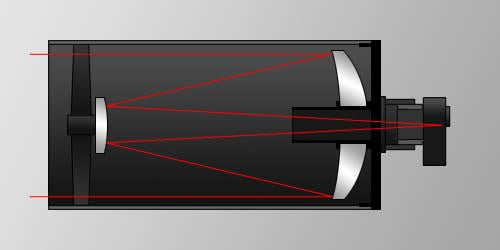
Classical Cassegrain Design

Above: Optical layout of a typical Cassegrain reflecting telescope
This section details the optical design and inherent aberrations of Cassegrain-type reflecting telescopes. For a more basic overview of these designs please see the Ritchey-Chrétien page and the Cassegrain page. For a review of the optical design terms, see the Optical Aberrationsand Optical Design sections.
Classical Cassegrain Design
The classical Cassegrain design uses a parabolic primary mirror, as in a standard Newtonian design. In fact, the primary mirror can often be used in a Newtonian configuration by switching out the secondary mirror. The primary mirror normally has a focal ratio of around f/4. Compare this to the faster focal ratio of the Ritchey-Chrétien (RC) design described below. The relatively slow focal ratio of the primary gives the classical Cassegrain a relatively long optical tube compared to an RC or Schmidt-Cassegrain telescope (SCT).
The secondary mirror in a classical Cassegrain is a convex mirror with a hyperbolic shape. The magnification factor of the secondary is normally in the range of 3x to 5x, giving the overall optical system a focal ratio of f/12 to f/20. This gives a very long focal length, well-suited to planetary observation or other high-resolution viewing or imaging. Occasionally faster systems of around f/8 to f/10 are seen, but these are less common. RCs are more common instruments in the shorter-focal-length range.
Classical Cassegrain Aberrations
A simple parabolic mirror, as in a Newtonian, suffers from coma. Adding the hyperbolic secondary prevents spherical aberration in the system but does not remove the coma. Like any all-reflecting Cassegrain design, the classical Cassegrain suffers from field curvature. A field-flattening lens is often incorporated to eliminate the field curvature for photographic applications. In the all-reflecting configuration there is no chromatic aberration, and distortion is negligible in this design.
Ritchey-Chrétien Design
The basic idea behind the RC design is a Cassegrain configuration that eliminates the coma inherent in the classical Cassegrain. This is especially important for astrometric (position) measurements. Coma is an asymmetrical aberration, displacing the apparent position of stars in an image and making precise measurements impossible. Astigmatism is a symmetric aberration, leaving the stars in their original positions, allowing astrometric measurements to be made. For this reason, many professional telescopes, including the Hubble Space Telescope, use an RC optical design.
Instead of the parabolic primary mirror of the classical Cassegrain, the Ritchey-Chrétien uses a hyperbolic primary. The primary focal ratio is usually faster than in a classical Cassegrain. A typical range is f/2-f/3. This can make the manufacture of the mirror more difficult and hence more expensive.
Like the classical Cassegrain, the RC uses a convex hyperbolic secondary. The secondary in an RC has a slightly stronger hyperbolic shape to compensate for the hyperbolic primary, which is itself a slightly stronger curve than a paraboloid. The magnification factor of the secondary is usually in the range of 2.5x to 3.5x, giving an overall focal ratio in the range of f/7 to f/9. Since they are intended more for high-resolution deep-sky imaging rather than planetary work, RCs are usually designed to be faster than classical Cassegrains.
Ritchey-Chrétien Aberrations
The RC trades coma for astigmatism. For astrometric purposes this is critical, but for taking pretty pictures it is hard to choose one aberration over the other. The combination of hyperbolic mirrors eliminates spherical aberration. As with all Cassegrain designs, the RC has fairly strong field curvature. It is possible to use a field-flattening lens to eliminate this for imaging purposes. In the all-reflecting configuration there is no chromatic aberration. Distortion is negligible in the RC design.
Other Cassegrain Designs
Rarely seen alternative configurations include the Dall-Kirkham and the Pressman-Camichel. Both of these designs are intended to simplify the design compared to an RC or classical Cassegrain by keeping one of the mirrors spherical. Spherical mirrors are far easier to manufacture than aspheric surfaces.
The Dall-Kirkham uses a spherical secondary in combination with an elliptical primary. The main drawback to the Dall-Kirkham design is that the coma is even stronger than in a classical Cassegrain, limiting the useful field of view. DKs are normally intended for high-power planetary observing where only a small field is used.
The Pressman-Camichel uses a spherical primary mirror, greatly simplifying the manufacture of the mirror. This, of course, comes at a cost. The secondary mirror must have a very strong elliptical shape which is harder to make. Ultimately the design suffers from a fairly mind-boggling amount of coma, limiting it to even smaller useful fields than the Dall-Kirkham.

